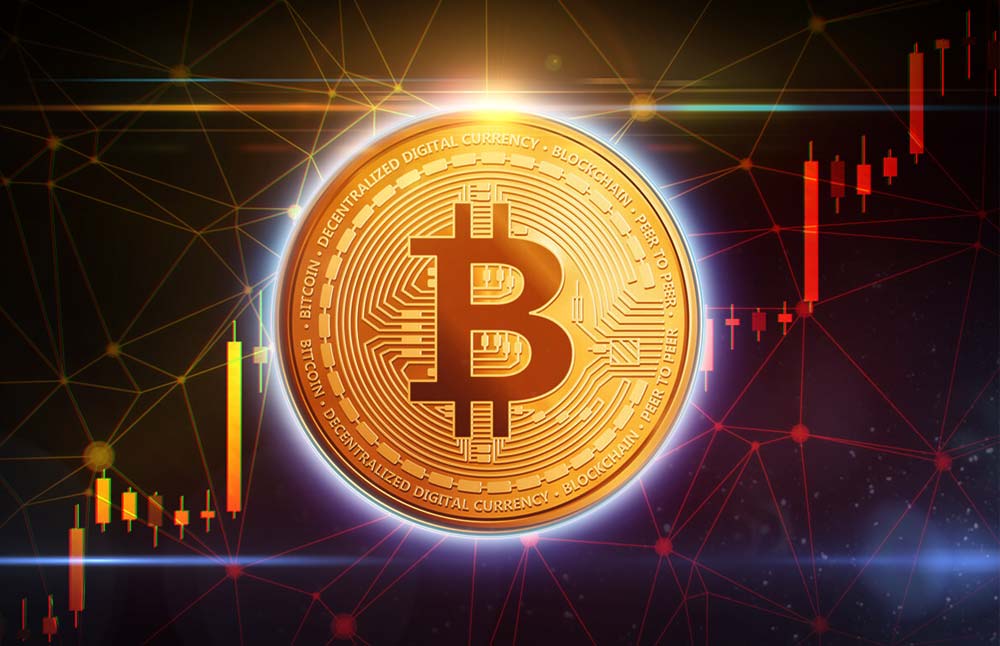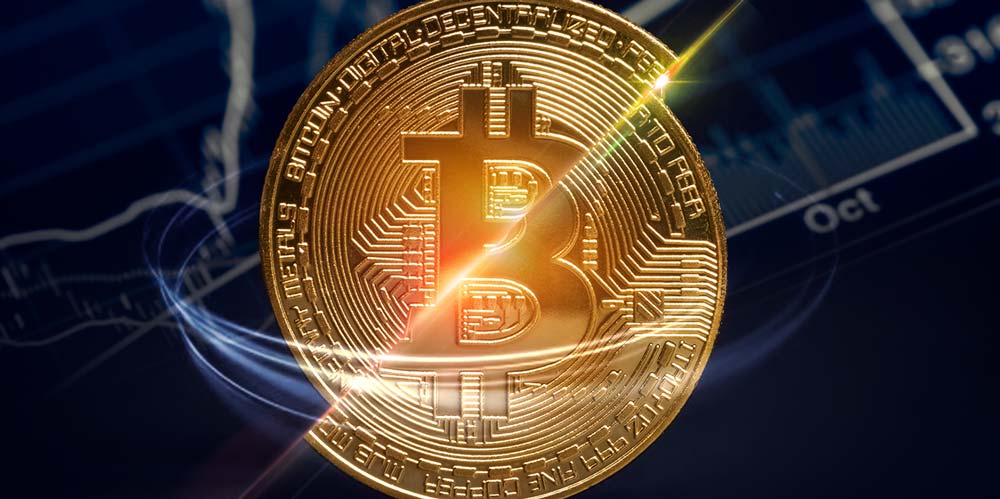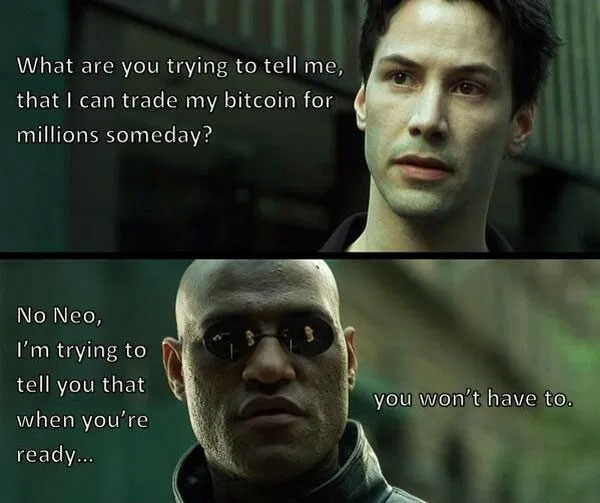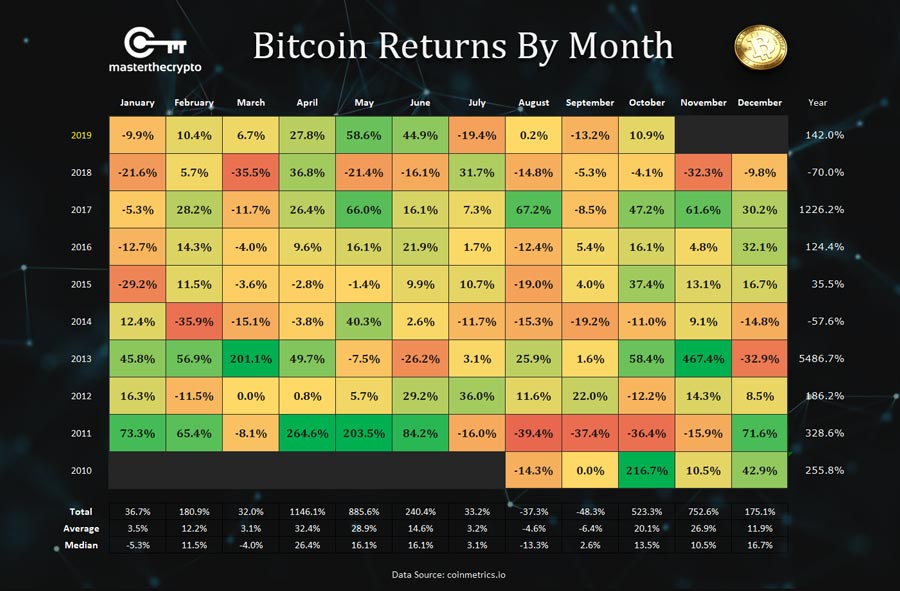Bitcoin Price Today: BTC/USD Exchange Rate Value Guide

Live Real-Time Bitcoin Price in BTC/USD Exchange Rate Value
The most asked question in today's cryptocurrency ecosystem is: what is the price of Bitcoin.

This bitcoin price guide is split up into four major analysis to understand how the BTC/USD exchange value rate works. First is the live real-time BTC price chart above, followed by these three core components:
- what the bitcoin exchange rate means (how the pricing formula of BTC in USD updates)
- most popular economic crypto market factors driving the price of bitcoin up (or down)
- historical bitcoin price timeline of events with chronological dates and BTC in USD news
What Does Bitcoin (BTC) Price’s USD Exchange Rate Mean?

Rank: 1
As we look at the bitcoin chart analysis of the last month's price in bitcoin, it is extremely significant to know the obvious, in that exchange rates play a crucial role in currency trading.
However, some people may not fully understand how exchange rates work. Today, we’re explaining everything you need to know about how bitcoin exchange rates work and how the price of bitcoin is determined.
The bitcoin network has been running for nearly 4,000 days (December 17, 2019 to be exact) since the open-source peer to peer BTC blockchain software began.
A decade ago, one bitcoin was worth less than a penny. Today, one bitcoin is worth around $10,000 and has an all time high of just under $19,900 BTC/USD. Clearly, bitcoin’s exchange rate has fluctuated wildly over the years as the volatility has even saw not one, not two, but three different 80% drawbacks down from previous chart highs.
The most demanding questions we will supply answers to are the following:
- How is an exchange rate like BTC/USD calculated?
- What types of factors go into the exchange rate?
- Why do exchange rates change?
- What causes bitcoin’s exchange rate to fluctuate wildly with volatility?
- What determines if bitcoin’s exchange rate goes up or down?
- Who sets bitcoin’s exchange rate and its USD calculation?
- Why are some fiat currency exchange rates fixed while others are floating?
- what was the past history price of bitcoin from 2009 to 2019?
- what are the bitcoin exchange rate value gains and losses month by month, year by year?
- what are the most common questions about the price of bitcoin measured in USD value?
We hope the cryptocurrency community is ready for this one-of-a-kind bitcoin price guide.
Here is a simple bitcoin price to USD conversion calculator as well as an easy way to exchange BTC for USD.
What is an Exchange Rate? How Do BTC in USD Exchange Values Work?
Whether we’re talking about cryptocurrency exchange rates or fiat currency exchange rates, exchange rates all work in pretty much the same way.
An exchange rate is simply a way of expressing one currency’s value to another. It tells you how much your currency is worth in a foreign currency.
The current exchange rate between the United States Dollar (USD) and the Canadian Dollar (CAD), for example, is approximately $1 USD = $1.30 CAD. That means your 1 USD is equivalent to $1.30 CAD.
You can also express exchange rates the opposite way. You can say $1 CAD = $0.76 USD. If you are exchanging CAD for USD, then you will need to pay $1 CAD to receive $0.76 USD in return.
As of November 2019, the exchange rate between bitcoin and the USD is roughly 1 BTC = $9,400 USD.
To help you understand exchange rates, it may help to think of an exchange rate as the price you need to pay in your currency to purchase another currency. If the BTC/USD exchange rate is 10,000.00, for example, then it means it costs $10,000 USD to buy 1 BTC. The exchange rate always shows how much of the second currency (USD) you need to purchase one unit of the first currency (BTC).
How Exchange Rate Pairs Work

Sometimes, we also see exchange rates expressed as a pair. A currency pair is a price quote of the exchange rate for two different currencies traded in foreign exchange (forex) or cryptocurrency markets.
When an order is placed for a currency pair, the first listed currency or base currency is bought, while the second listed currency in the pair – the quote currency – is sold.
The EUR/USD currency pair is the most liquid currency pair in the world. With this pair, one party is selling EUR for USD, while the other party is buying EUR for USD.
Sometimes, currency pairs will be expressed like this: EUR/USD = 1.200. This means that you can sell the first currency (EUR) to receive the second currency (USD) in the listed amount. You can sell 1 EUR for $1.2 USD.
There are as many currency pairs as there are currencies in the world. From major currency pairs like the USD and JPY to smaller currency pairs like the North Macedonian Denar (MKD) and Albanian Lek (ALL), there’s no limit to the number of currencies you can buy and sell today.
Where Do Exchange Rates Come From?

Most foreign currencies and cryptocurrencies are traded 24 hours a day, 7 days a week. Over $5 trillion of fiat currency changes hands every day worldwide.
We look at these transactions to determine the current exchange rate. How much did someone just pay to buy the USD with BTC? How much did someone pay in CAD to buy USD?
With all currencies, prices change constantly. Mexican Pesos are being constantly traded with US Dollars, for example. Euros are being constantly exchanged for Russian Rubles. These currency transactions occur constantly, and these transactions determine the exchange rate.
Fixed Versus Floating Exchange Rates
Most major world currencies use a floating exchange rate. The exchange rate changes at any time due to supply and demand. Some countries, however, use fixed exchange rates. The exchange rates of these currencies cannot change. The rate is fixed or pegged to something.
Under a floating exchange rate, a limitless number of factors can influence exchange rates. When the United Kingdom voted to leave the European Union, for example, the value of the British Pound (GBP) fell relative to the Euro, US Dollar, and other major world currencies.
Exchange rates can be influenced by countless factors, which is why most exchange rates fluctuate throughout the day.
Certain countries, however, do not have floating exchange rates. They have fixed exchange rates. These countries will peg their currency to the US Dollar or a similarly stable currency, then maintain those rates over a long period of time.
The Saudi Arabian Riyal, for example, has a fixed exchange rate. It only changes in value when the government decides to change its value.
China, meanwhile, had a similar system for a long time with the Yuan. The value of the Yuan was kept artificially low against the US Dollar to make Chinese goods more attractive for exporters. Today, China has moved away from this system, although the Yuan is still not allowed to fully float. Instead, the Yuan is allowed to move within a small band.
Do Governments or Central Banks Control Exchange Rates?

Most major countries today use flexible or floating exchange rates. The United States government, for example, cannot directly change the exchange rate of the USD with other fiat currencies. The exchange rate floats on purpose.
Most central banks don’t directly change exchange rates. However, central banks may issue policies to indirectly impact exchange rates over the long term.
Central banks can adjust interest rates and impact inflation, for example, both of which can affect the exchange value of a currency against global currencies.
Some Governments Do Directly Control Exchange Rates

Most national governments do not directly interfere with exchange rates. However, governments in certain countries do directly impact exchange rates.
The Saudi Arabian Riyal, for example, rarely fluctuates against global currencies because the Saudi government uses a fixed exchange rate. This exchange rate only changes when the government decides to change it.
The Chinese Yuan, meanwhile, had a fixed exchange rate for decades, although the Chinese government is now transitioning to a flexible exchange rate. Today, the Yuan’s exchange rate changes less frequently than currencies with a flexible exchange rate, but it changes more frequently than currencies with a fixed exchange rate.
When a government maintains a fixed exchange rate, that exchange rate is usually pegged to the US Dollar. Some countries – like Singapore, for example – peg the value of their currency to a basket of assets, including the US Dollar and other major currencies or global assets.
What Affects a Currency’s Exchange Rate?
All currency exchange rates are influenced by supply and demand – including the exchange rate for bitcoin, the US Dollar, and other currencies.
How much are people willing to pay for one bitcoin? How many bitcoins are available? Based on the answers to these two questions, the price of bitcoin will rise or fall.
Of course, supply and demand are intricately linked to thousands of different factors.
in the traditional currency world, three factors influence the exchange rate:
Interest Rate: Most countries have a central bank that pays an interest rate. A higher interest rate makes the currency more valuable because investors want to invest in that country, taking advantage of high interest rates by switching their money to that country’s currency. Investors will exchange their currency for the currency that pays higher interest, then save it in that country’s bank to take advantage of those high rates.
Money Supply: Most central banks also control the money supply. The United States Bureau of Engraving and Printing, for example, prints 38 million notes a day with a face value of about $541 million. When more money is printed, it weakens the value of the money in circulation. There’s too much money chasing too few goods and services. People who hold money will bid up the prices of goods and services, creating inflation. If far too much money is printed, then we see hyperinflation – like what we saw in 1920s Germany or modern Zimbabwe.
Economic Growth and Financial Stability: A country with a strong, growing economy will attract investors. These investors will buy the country’s goods and services. They need to buy the country’s currency to do so, which causes the price of that currency to rise. Contrarily, if the country’s economic growth and financial stability weakens, investors will want to sell their assets, creating downward pressure on the currency and causing prices to fall.
All three of these factors have a significant impact on fiat currency prices. Next, we’ll take a look at how certain factors affect the price of bitcoin.
What Affects Crypto Exchange Rates?

All of the above factors play a crucial role in exchange rates in fiat currency markets. But what about crypto markets?
In crypto markets, exchange rates are primarily governed by the same two broad factors: supply and demand.
Supply: How many tokens are available to be purchased? How rapidly is supply growing every year? How many tokens are locked up? How many tokens are available through exchanges or in the hands of the public?
Demand: How much is someone willing to pay for each token? How badly do people want to buy a particular token? What types of attractive features does the currency have that no other currencies have?
When demand and supply are equal, a cryptocurrency’s value stays equal. When demand outpaces supply, meanwhile, prices rise. We’ve seen this with bitcoin over the last decade: bitcoin has a fixed supply of 21 million, with a declining number of tokens released periodically. As demand has risen for bitcoin, and supply has stayed the same, the price per bitcoin has inevitably risen.
Of course, supply and demand are made up of thousands of different factors themselves.
A cryptocurrency with a strong developer community, great app support, and lots of hype, for example, will have strong demand. Thousands of factors can influence demand.
How Does Bitcoin’s Exchange Rate Work?

Bitcoin’s exchange rate works in a different way than traditional national currencies.
Sure, bitcoin’s exchange rate is influenced by some of the same factors.
The money supply (or total supply) of bitcoin plays a role, for example, as does the inflation rate (emission rate or block reward) of bitcoin.
Unlike with national currencies, however, bitcoin’s exchange rate is not affected by any specific national economy. A country’s central bank cannot change its interest rate to influence the exchange rate of bitcoin, for example. There’s no bitcoin central bank that can choose to release more bitcoins.
Bitcoin’s exchange rate is also not really influenced by financial cycles. The quarterly GDP growth of a country doesn’t impact bitcoin, nor do the natural recessionary and inflationary cycles.
Up above, we talked about how two simple factors influence every currency exchange rate in the world: supply and demand. Just like fiat currencies, cryptocurrency exchange rates are influenced by thousands of subfactors that make up supply and demand.
Which Countries Have Fixed Exchange Rates? Are They Good or Bad?

Some believe that controlling an exchange rate is a good idea. Clearly, it worked out well for China and Saudi Arabia over the last few decades.
When most people hear about a fixed exchange rate, they think about the Chinese Yuan and Saudi Arabian Riyal.
You may be surprised to learn, however, that the United States and most major countries had a fixed exchange rate for most of the last century.
Throughout the 1800s and 1900s, the United States gradually accumulated most of the world’s supply of gold. The U.S. government fixed the price of gold at $20.67 an ounce with the Gold Standard Act of 1900.
That price would stay the same until 1934, when the Gold Reserve Act prohibited private ownership of gold and authorized President Franklin Delano Roosevelt to devalue the US Dollar. Overnight, the government increased the price of gold from $20.67 per ounce to $35 per ounce. The dollar was devalued by 60%, although the value of the government’s gold reserves increased in value from $.033 billion to $7.348 billion overnight.
Most other companies recognized the value of a stable currency, and the United States was rapidly becoming a global superpower. Thus, in 1944, most countries of the world signed the Bretton Woods Agreement, thereby agreeing to peg their currencies to the US Dollar.
This gold standard lasted all the way until 1971, when President Nixon removed the US Dollar from the gold standard. From this point forward, the US Dollar has maintained a floating or flexible exchange rate.
Pros and Cons of a Fixed Exchange Rate

Whether dealing with fiat currencies or cryptocurrencies, fixed exchange rates can be good or bad. Some of the pros and cons of a fixed exchange rate include:
Pros
Stability: The first and most important advantage of a fixed exchange rate is that it can create stability. Investors know what a currency is worth. They can invest in a country and know that the investment isn’t going to wildly fluctuate because of currency valuation.
Smaller Countries Benefit from the Strength of Stronger Countries: More countries peg their currency to the US Dollar than any other currency in the world. Why? Well, the United States has a strong and diversified economy. When the US Dollar grows, any country that uses the US Dollar can indirectly benefit from that growth. If your fiat currency is pegged to the US Dollar, and the US Dollar rises in value, then your fiat currency also rises in value.
Cons
Fixed Exchange Rates Are Expensive to Maintain: Most governments maintain a fixed exchange rate by maintaining large foreign currency reserves. For a country as large as China, vast foreign currency reserves are needed to keep the currency stable. These reserves are costly to maintain.
Makes a Country a Target for Speculators: Fixing an exchange rate can make a country a target for speculators. Speculators can short the currency, artificially driving down the value of the currency. The central bank must convert its foreign exchange to prop up its currency’s value. If the central bank doesn’t have enough, then it will have to raise interest rates, causing a recession. We saw this with the British Pound in 1992, when George Soros kept shorting the pound until the UK’s central bank gave up and allowed the pound to float. We also saw it with Switzerland in 2015, when the government released the Swiss Franc from its peg to the Euro.
Black Markets Can Subvert Fixed Exchange Rates: Governments often try to implement a fixed exchange rate to enjoy the advantages listed above, only to fail with the actual implementation of that fixed exchange rate. We’ve seen this occur in Venezuela and other countries. The government of Venezuela has officially pegged its currency to the US Dollar to regain economic stability. However, most citizens are privately willing to accept a much different exchange rate through black markets. The black market exchange rate is much different from the official exchange rate, undermining the government’s attempt to create stability.
Fixed Exchange Rates in Crypto

We see fixed exchange rates in the crypto world. They’re most often seen with stablecoins.
Stablecoins are cryptocurrencies that have a deliberately stable value. The vast majority of stablecoins on the market today are pegged to the US Dollar. They maintain their stable value by holding 1:1 US Dollar cash reserves.
Stablecoins like the Gemini Dollar (GUSD) and Tether (USDT) work in this way: these companies release digital tokens 1:1 with their cash reserves. GUSD and USDT token holders can exchange these tokens at any time for US Dollars. As long as you can exchange 1 GUSD for 1 USD, then 1 GUSD will always be worth 1 USD on the market.
Some Countries Use Loosely Fixed Exchange Rates

Some countries have created a unique solution. They have created loose exchange rates. These exchange rates have a certain trading band. The exchange rate is allowed to float within this band.
The goal of a loosely fixed exchange rate is to give the currency the adaptability of a floating exchange rate combined with the stability of a fixed exchange rate. When properly implemented, it can work quite well.
There are three major fiat currencies that currently use loosely fixed exchange rates:
China: The Chinese Yuan (CNY) has a 2% trading band based around yesterday’s midpoint. The exchange rate is allowed to float within this band before the government takes action to stabilize the exchange rate. The Yuan is fixed to a basket of assets (which mostly consist of US Dollars).
Singapore: The Singapore Dollar (SGD) is managed within a trading band to allow a slow rise in value. It’s fixed to a basket of assets.
Vietnam: The Vietnamese Dong (VND) has a 2% trading band, although the government periodically devalues the currency beyond this range (as occurred in December 2016). The Dong is pegged to the US Dollar.
Cryptocurrency Exchange Rates Cannot Be Influenced by Central Banks

Central banks and other government entities have some influence over fiat currency exchange rates. The US Federal Reserve can adjust interest rates, for example, to indirectly impact exchange rates.
One of the biggest advantages of cryptocurrency is that exchange rates lie outside the domain of government decision-making.
Bitcoin is the world’s first truly global currency. It’s not tied to the economic performance of any single country. A central bank cannot singlehandedly impact the price of bitcoin.
If the US economy goes into a recession, then the value of the US Dollar is expected to drop. The value of bitcoin, meanwhile, may not change relative to other global currencies, because bitcoin isn’t just linked to the US economy.
Crypto Exchange Rates Aren’t Immune from Government Intervention

Of course, even the most hardcore cryptocurrency advocates will admit there’s a flaw with cryptocurrencies: governments can still impact cryptocurrency exchange rates in multiple ways.
Governments Can Hold a Crypto Reserve Fund: Let’s say the United States government wants to control the BTC/USD exchange rate. They decide to buy 1 million BTC and hold it in a reserve fund. If the BTC/USD exchange rate starts getting too high, the US government sells some of this fund, creating selling pressure on markets and causing prices to drop.
Governments Can Ban or Restrict Crypto: The Chinese government banned many aspects of crypto trading in 2017. This caused bitcoin prices to plummet, although the effect was short-lived. Many people saw this as a positive sign: even a country as large and powerful as China cannot singlehandedly influence bitcoin’s value long-term. However, think of what would happen if multiple countries banned bitcoin overnight. What would happen if the EU suddenly changed the way it treated bitcoin? What happens if the US government decides to ban bitcoin?
Because of these two drawbacks, governments can still influence crypto exchange rates in various ways.
Overall, however, cryptocurrency exchange rates are largely dictated by two market forces: supply and demand. Cryptocurrency exchange rates aren’t fixed to any specific government, nor are they pegged to a specific value or fiat currency. This is one enormous difference between cryptocurrency and fiat currency exchange rates.
Exchange Rates and Conversion Spreads

In cryptocurrency and fiat currency markets, there’s never just one specific cryptocurrency exchange rate.
Sure, the BTC/USD exchange rate could be around 10,000.00, but you’re unlikely to see that exact exchange rate from every exchange and bank.
When there’s a difference between exchange rates, it’s called the conversion spread. The conversion spread is different from the market price that a trader will get.
A bank, currency exchange, or cryptocurrency exchange will markup the price so they make a profit. Credit cards, PayPal, and other money services operate in the same way.
Let’s say the USD/CAD exchange rate is 1.30. You might travel to the United States and buy a case of beer using your CAD credit card for $10 USD. If you paid a market rate, then your total charge would be $13 CAD. In reality, however, your credit card company will charge an additional exchange rate of, say, 2.5%. The price you see on your credit card will be $13.25 CAD because of this added fee.
Banks, currency exchanges, and cryptocurrency platforms charge conversion spreads to cover their service fees. Some charge additional fees on top of this, while others – like credit card companies – only charge foreign exchange fees.
Next, we’ll talk about the specific factors that influence the price of bitcoin, but first we have a very special chart to show you of the month by month breakdown of the bitcoin price action.
BTC Price Chart Gains/Losses Month by Month, Year by Year
Now, here is an extra sweet graphic made illustrating every month of Bitcoin's price gains and losses, as well as a review summary of what all of these numbers represent.
Most people look at bitcoin’s price as a continuous chart. Bitcoin is traded 24 hours a day, 7 days a week, all over the world. It doesn’t follow traditional financial market cycles. There are no quarterly bitcoin profit reports.
However, you can still glean certain information from how bitcoin moves in each month. Here’s a chart of bitcoin’s price movements every month from August 2010 (the launch of the first bitcoin exchange rate tracker) all the way to October 2019.
The data was compiled by Cane Island Alternative Advisors, a Texas-based crypto analysis firm, with data collected from Coinmetrics.
The chart looks like a bit of a mess, with few discernable patterns. However, here’s some of the information we can get from the chart:
- Bitcoin had its best month in November 2013, when prices rose 467.4% between November 1 and 30
- On average, bitcoin experiences its biggest positive price movements in April (32.4% average) and May (28.9% average), which is significantly higher than any other month
- August and September are the only months where bitcoin had a negative average price movement, with drops of 37.3% and 48.3%, respectively
- October and November have the next biggest average price jumps after May and June, with jumps of 20.1% in October and 26.9% in November, on average
- In total, bitcoin has gained 1146.1% cumulatively in the months of May between 2011 and 2019, which is a higher cumulative rise than any other month
- Bitcoin has experienced similarly impressive cumulative price rises in all months of May (885.6%), November (752.6%), and October (523.3%)
- Bitcoin’s biggest ever year-long price jump occurred in 2013, when bitcoin’s price rose 5486.7% from January 1 to December 31
- Bitcoin has only had two negative years: in 2014, bitcoin’s price dropped -57.6% from the start to end of the year; and in 2018, bitcoin’s price dropped -70% from the start to end of the year
- Bitcoin has had two months where its price remained perfectly neutral, changing 0.0% on average from the first to last date of the month: September 2010 and April 2012
- Bitcoin’s worst month in history was August 2011, when bitcoin dropped -39.4% from the first to last date of the month
- Bitcoin’s second and third worst months, interestingly, occurred immediately after its worth month: bitcoin dropped 37.3% in September 2011 and 36.4% in October 2011
Now, let's transition into the top 20 driving forces responsible for moving the price of bitcoin up and down.
Top 20 Factors Influencing the Price of Bitcoin

Thousands of individual factors influence the price of bitcoin. We’ve outlined the top 20 factors below.
Maximum Supply of Bitcoin
Bitcoin is the only major currency in the world with a specific, predetermined, fixed limit. There will only ever be 21 million bitcoins in existence. This limit is hardcoded into bitcoin.
The actual supply of bitcoin, of course, is already much less than that. Millions of bitcoin have been lost, locked away, or destroyed. Some people believe as many as 4 million bitcoins are no longer accessible.
Out of the 18 million bitcoins mined to date, it could mean that only 12 or 13 million are actually circulating, and only another 3 million remain to be printed over the next 120 years (the last bitcoin is scheduled to be mined in 2140).
Emission Rate (Block Reward)
Just like a central bank, the bitcoin blockchain prints new money every year. Every 10 minutes, the bitcoin blockchain releases 12.5 BTC into the economy. This is the block reward, and it’s given to the bitcoin miner who mined that block.
It helps to think of the emission rate as the inflation rate of bitcoin. As new bitcoins are minted, it should drop the price of bitcoin (assuming demand remains steady), causing inflation. However, the emission rate of bitcoin is so low that it does not keep up with rising demand. That’s why the price of bitcoin has continued rising year after year.
Bitcoin’s emission rate drops periodically. Initially, the bitcoin blockchain gave out 50 BTC as a block reward. Then, that number dropped to 25 BTC. Today, it sits at 12.5 BTC, with another block reward ‘halving’ scheduled to occur on May 14, 2020. On this date, bitcoin’s block reward will drop to 6.25 BTC, which means bitcoin’s inflation rate essentially gets cut in half overnight.
The Dwindling Supply of Bitcoin
It’s not just the supply of bitcoin that’s a factor, but it’s also the fact that the supply of new bitcoins is dropping. We’ve mined 18 million bitcoins to date (as of November 2019). There are just 21 million bitcoins that will ever be produced, which means we’ve mined 85% of the total supply of bitcoin.
What’s even more surprising is that we won’t mine the last bitcoin until the year 2140!
Due to bitcoin’s dwindling block reward system, bitcoin’s block reward will continue getting cut in half until just a few tenths or hundredths of a bitcoin are being mined every day.
Finally, in the year 2140, the bitcoin blockchain will have mined the last bitcoin, at which point no new bitcoins will ever be created.
Economic Growth in the Bitcoin Community
Bitcoin isn’t tied to the economic growth of any specific country. However, there’s still an entire bitcoin economy out there. This bitcoin economy doesn’t work quite like the economy of the United States or China.
However, bitcoin’s economy is still impacted by things like consumer spending. How often are people actually using bitcoin to spend? How often are people making transactions in bitcoin? What kinds of goods or services is someone willing to provide for 0.5 BTC?
Bitcoin’s economy is also influenced by its community support and development. Are developers contributing to the project? Are community members supporting bitcoin apps?
Bitcoin’s community has its own economy, and as that economy grows, it influences demand for bitcoin.
Available Supply of Bitcoin
This is the third time we’ve mentioned supply as one of the factors influencing the price of bitcoin. The available supply of bitcoin, however, can be significantly different than the actual circulating supply.
We know that 18 million bitcoins have been mined to date. However, we also know that not all 18 million of those bitcoins are still circulating.
A certain number of bitcoins are being held by people who will never sell them below a certain price, for example. A certain number of bitcoins have also been lost or destroyed over the years and will never be recovered.
With these factors in mind, the formula for calculating the available supply of bitcoin looks like this:
Available Supply = Circulating Supply – Bitcoins that Are Being Held or Lost
We know there are 18 million bitcoins in existence. Now, let’s assume that two million of those bitcoins have been lost. People throw out hard drives. People forget their passwords. People accidentally destroy or wipe out old computers. Because of these lost or destroyed bitcoins, we have only 16 million bitcoins in circulation.
Now, let’s assume that of the remaining 16 million bitcoins held by people, 15 million of them would never sell their bitcoins for anything less than $20,000 apiece.
In this scenario, the available supply of bitcoin at any price underneath $20,000 would be 1 million BTC.
This plays a crucial role in the price formation of bitcoin. Let’s assume we have a bunch of buyers who want to invest in bitcoin. They want to buy 10,000 BTC regardless of the price. These buyers hit the market, targeting the 1 million bitcoin holders willing to sell for a price below $20,000. Eventually, the sellers dwindle, and the price gets pushed upward. Eventually, the price gets pushed high enough that it may break $20,000, which is the point at which certain people are willing to sell their bitcoin.
Ultimately, this phenomenon of prices rising and falling creates a back and forth dance. Buy and sell volume continues fluctuating endlessly, creating volatility in the markets until prices settle.
Apps and Software Development
Bitcoin is open source, and anyone can build anything on bitcoin. As bitcoin’s usage has increased, so too has the demand for apps and software to enhance the usability of bitcoin.
App and software developers face a catch-22 situation with bitcoin. As demand for bitcoin increases, the demand for good bitcoin apps and software also increases. But for app and software developers to build on bitcoin, they first need to see some demand for their apps and software.
Despite this catch-22 situation, app and software developers continue to build great things on bitcoin. Some software interacts directly with the bitcoin ecosystem: wallet apps let you securely hold bitcoin on your mobile device, for example.
Other software doesn’t directly connect to the bitcoin blockchain in any way. A portfolio tracker app, for example, simply checks the price of bitcoin and tells you how valuable your portfolio is.
As more apps and software are built on bitcoin, it enhances demand for bitcoin. It makes bitcoin easier to use. You start using bitcoin. You try to get your friends to start using bitcoin. There’s less effort required to participate it bitcoin. There’s less of a learning curve. With fewer barriers to entry, there’s never been a better time to enter.
Accessibility and Ease of Purchase
In the early days of bitcoin, it was relatively hard to use bitcoin. You needed to download the full bitcoin software just to hold bitcoin, for example.
Today, buying bitcoin is as easy as downloading a mobile app and inputting your credit card information. Some people can buy bitcoin from their ordinary investment platforms – like Robinhood, Fidelity, or TD Ameritrade.
As bitcoin’s ease of use increases, it becomes increasingly accessible to a wider group of people. In 2011, someone might have heard about bitcoin and been interested in buying bitcoin but was dissuaded by the high learning curve and complicated purchasing process. Today, that same person faces few hurdles on her way to purchasing her first bitcoin.
Competition from Altcoins and Banks
Back in 2009 when bitcoin first launched, it had no competition. It was the only blockchain-based, cryptographically-secured currency in the world. People didn’t even know what blockchain was.
Today, things have changed, and bitcoin has plenty of competition. Bitcoin’s competitors are faster and more scalable. Some of them are more anonymous or privacy-focused.
One thing, however, has remained constant throughout crypto history: bitcoin has remained the world’s largest cryptocurrency by market cap. From 2009 to 2017, bitcoin’s dominance sat somewhere between 90% and 100%. That means out of all the money in crypto, 90% to 100% of that money was in bitcoin.
From 2017, things have changed. In January 2018, bitcoin’s dominance reached an all time low of around 36%. More money was in competing altcoin markets than in bitcoin.
Today, bitcoin’s dominance has once again risen. As of November 2019, the BTC dominance index sits at around 70%.
Of course, things can easily change in the future. Bitcoin had the first mover advantage, but it faces competition from some of the world’s elite development teams. There are faster and better cryptocurrencies on the market, but none of these competitors have challenged bitcoin’s dominance as of yet.
Plus, bitcoin is facing competition from more than just altcoins. Banks are making their own free money transfer services – like Venmo. Corporations are also launching their own digital currencies – like Facebook’s Libra, which is backed. All of these may be competition for bitcoin.
Cost of Production
Cost of production plays a crucial role in the price of bitcoin. Yes, bitcoin is a virtual currency, and there’s no physical ‘bitcoin’ that needs to be manufactured. However, there are still real production costs involved in bitcoin, including mining and electricity consumption.
Mining bitcoin requires the use of enormous amounts of energy to power server farms. These server farms work to create a cryptographic solution. The first computer to find that solution receives the block reward.
As more miners join the bitcoin ecosystem, it becomes harder and harder to mine bitcoin. Difficulty increases, which means it takes more electricity and computing power to solve each cryptographic puzzle.
Theoretically, there doesn’t have to be a connection between bitcoin’s market price and its mining costs. In practice, however, we find that bitcoin’s price is closely related to its marginal cost of production.
Regulatory and Legal Issues
It’s true that individual governments do not have full control over bitcoin. However, it’s also true that individual governments can issue regulations that significantly impact bitcoin.
We saw this in September 2017 when China banned bitcoin exchanges from operating in the country. Bitcoin’s price plummeted (although it later rebounded to its all time high by the end of the year).
We’ve also seen this in New York, which was the first state to introduce crypto-specific regulations that exchanges need to follow. Today, many crypto exchanges continue to ban New York residents from participating in the exchange because these exchanges don’t want to abide by BitLicense requirements.
What happens if the IRS suddenly decides that bitcoin is non-taxable? What happens if the United States government bans the purchase of bitcoin tomorrow? What happens if the European Union issues regulations strictly prohibiting the use of cryptocurrency exchanges?
All of these situations are feasible. Some regulations will cause the price of bitcoin to plummet, while others will cause the price to rise or stay the same. But clearly, regulatory and legal changes have a significant impact on the price of bitcoin.
Availability on Local and International Exchanges
The world’s largest cryptocurrency exchanges accept popular fiat currencies like the US Dollar and Euro. However, most cryptocurrency exchanges do not accept smaller fiat currencies. Most cryptocurrency exchanges do not have an AUD/BTC pair, for example, or a CAD/BTC pair. Instead, Australians and Canadians need to go to special exchanges to trade their Australian or Canadian Dollars for bitcoin.
As bitcoin becomes more available on global exchanges, it becomes easier for people around the world to purchase. Some of the biggest opportunities for bitcoin to grow are in developing parts of the world: over 2 billion people worldwide are underserved by traditional banks but could benefit significantly from bitcoin.
Every time a crypto exchange opens in a new, underserved part of the world, it increases the availability of bitcoin, lowering barriers to entry and addressing increasing demand.
Media Coverage
Media coverage of bitcoin has a huge influence on demand for bitcoin, so it’s not surprising that media can significantly influence the price of bitcoin.
Positive media attention can cause bitcoin prices to skyrocket. Suddenly, it seems like everyone is talking about bitcoin in a favorable light and sees it as the new digital gold.
Meanwhile, negative media attention can cause demand for bitcoin to plummet. Major media outlets may call bitcoin a scam or a pyramid scheme, for example, convincing users to sell their bitcoin and causes prices to plummet.
Forks and Development Milestones
Bitcoin has undergone several major forks in its history, including soft forks and hard forks. The biggest hard fork to date, however, occurred on August 1, 2017, when bitcoin split into bitcoin (BTC) and Bitcoin Cash (BCH).
When forks or major development milestones occur, it can send ripples through markets. Bitcoin’s price fluctuated wildly in the days leading up to the hard fork. Although markets may not fully understand how these hard forks work or what their ultimate impact will be, it’s obvious that these hard forks have a significant impact on supply and demand.
Internal Governance
Bitcoin has no board of governors. There’s no centralized corporation in charge of bitcoin’s decisions. Bitcoin’s governance is decentralized.
However, there are still, by necessity, central figures behind bitcoin’s governance. There are lead bitcoin developers responsible for bitcoin’s biggest changes. There are people who own certain domains – like bitcoin.com or bitcoin.org – who can influence communities.
Inevitably, there are disputes within this governance structure. Sometimes, these disputes are resolved without issue. In other cases, they lead to hard forks. When internal governance problems strike bitcoin, it can affect market supply and demand.
Security Issues, Hacks, and Data Breaches
There have been hundreds of crypto exchange hacks, security breaches, data losses, and other issues over the years. When these breaches occur, it can send shockwaves through the market.
If an exchange gets hacked and loses $100 million of customer funds, for example, then it can cause panic in the marketplace. People might try to sell their bitcoin and withdraw their funds quickly, for example.
Or, if someone’s personal information, private keys, or other data gets leaked, then it can cause a similar panic. Security issues can create downward selling pressure on the market.
At the same time, new advancements in security can give the market greater peace of mind. A new, affordable wallet can give people peace of mind that their funds are safe in bitcoin, for example, creating upward pressure on markets.
Bitcoin Scams and Pyramid Schemes
We’ve all heard the stories of effortless crypto millionaires: people who bought huge amounts of bitcoin at the right time, then held onto that bitcoin until it was worth millions of dollars. We’d all like to make easy money, which is why scammers often target new bitcoin users with get rich quick schemes.
There have been plenty of scams in bitcoin’s history – from exit scams to pyramid schemes to fraudulent investment programs. When a bitcoin scam is uncovered or shut down, it casts all of bitcoin in a negative light, which can significantly impact the price of bitcoin.
Events
All types of events can impact the price of bitcoin, including:
- The shutdown of major marketplaces that use bitcoin (like the infamous drug marketplace Silk Road)
- The announcement of government regulations
- An exchange hack or security breach
- Announcement of tax changes
- Global recessions or major economic events
- Hard forks
- A whale moving a large number of coins to the market
- A wallet untouched since the early 2010s suddenly moving huge numbers of bitcoins
- The launch of a competing cryptocurrency
- Political events, like the election of a crypto-friendly president
All of these events can have varying effects on the price of bitcoin.
The Launch of New Computing Technology or Miners
Bitcoin mining is all about mining the most bitcoin with the fewest resources. With that goal in mind, miner manufacturers like Bitmain have created highly-specialized computers dedicated solely to mining bitcoin. These highly-efficient machines produced the highest possible hashrate with the least amount of electricity.
As technology grows, miners become more and more efficient. In the early days of bitcoin, you could mine bitcoin with an average gaming PC graphics card. Today, you can barely make a profit even with specialized miners.
The launch of new computing technology affects miners’ profits significantly, and that can impact the price of bitcoin.
In the future, we may have to deal with the launch of quantum computers. Quantum computers will be able to blast today’s computers out of the water. Some believe this will instantly cause the destruction of the bitcoin network. Others believe we can avoid this was quantum-resistant upgrades.
The Intrinsic Value of Bitcoin’s Software and Blockchain
Crypto critics will often claim that bitcoin has “no intrinsic value”. There’s nothing backing bitcoin, so how can it be worth anything over the long term?
In reality, most modern fiat currencies aren’t technically backed by anything either. No major currency is on the gold standard, for example. Some modern economies – like Canada – don’t even own significant amounts of gold anymore. Instead, these fiat currencies get their value ‘by decree’ of the government. They have value because you trust the government of the United States or Canada.
Similarly, bitcoin’s intrinsic value comes from its underlying software, which is the bitcoin blockchain. Bitcoin’s blockchain is a technological innovation that solved crucial issues with digital money. It solved the double spend issue, for example, and the Byzantine Generals’ Problem. Because of the bitcoin blockchain, we have a secure version of digital money that runs without a centralized entity and cannot be hacked. That’s the value of bitcoin.
How People Use Bitcoin and See Bitcoin as a Currency
There’s considerable debate within the bitcoin community over how bitcoin should be used. Some people believe bitcoin should be used exclusively as a store of value: we don’t hand over chunks of gold to buy our morning cup of coffee, so why should we treat bitcoin differently?
Others believe that bitcoin should be used as a means of exchange. It should be used for daily purchases.
The issue comes down to the three properties of a currency. A currency, by definition, should serve three basic functions:
Means of Exchange: The currency should be used as a way to exchange goods and services. The value of the currency will be based off the value of the goods and services people are willing to give in exchange for the currency.
Store of Value: A currency must retain its value when stored. If you temporarily hold an asset and it loses a significant amount of its value, then it’s not a very good currency.
Unit of Measurement: The currency needs to function as a unit of measurement. Someone can say that a gallon of milk costs $4 today, for example. The currency is used to track the value of goods or services. If a gallon of milk costs $4 today and $300 tomorrow, then the dollar will no longer be used as a unit of measurement, and it won’t be considered a good currency.
Does bitcoin fulfill the definition a currency as listed above? Based on your opinion, this can significantly affect the value of bitcoin. Let’s take a closer look at how bitcoin functions for each of the purposes above:
Bitcoin as a Means of Exchange: Some people believe bitcoin should be used as a means of exchange. You should be able to use bitcoin at Starbucks, for example, or to buy a new car. A growing number of businesses and merchants worldwide now accept bitcoin as payment. As scaling technology improves, it’s becoming easier for bitcoin to be accepted globally as a means of exchange.
Bitcoin as a Store of Value: Bitcoin is most controversial when used as a store of value. You might buy 1 BTC for $10,000 today. Within a year, it’s not unreasonable to think that 1 BTC is worth anywhere from $2,000 to $30,000. Does that really make bitcoin a good store of value? Typically, stores of value are stable. Prices can go up or down, but the asset holds its value. Of course, you can also argue that bitcoin is the best store of value because it’s insulated from central banks, politicians, national economies, and similar things – all of which can affect fiat currencies.
Bitcoin as a Unit of Measurement: Bitcoin is worst when used as a unit of measurement. If you tell someone your gallon of milk costs 0.0005 BTC, they’ll have no idea what you’re talking about. Even crypto enthusiasts don’t use bitcoin as a unit of measurement. We constantly talk about bitcoin in relation to US Dollars. We enthuse when the price of bitcoin eclipses $20,000 USD, for example.
The three factors above all impact bitcoin’s strength as a currency. As bitcoin’s strength as a currency increases, we can naturally assume that its value rises.
Now let's reverse gears and talk about the history of bitcoin and its price in USD.
Bitcoin Price History: Year by Year Timeline Overview
Anyone studying the price of Bitcoin will want to know how the bitcoin exchange rate has changed over time. And we brought it allllllll the way back, from January 3, 2009 to November 2019, this is the most comprehensive list of month by month and year by year bitcoin price action watch compilation.
In this section of our bitcoin price guide, it has 2 mini-big sections:
a) yearly bitcoin price history overview 2009-2019
b) historical bitcoin price timeline chart with dated news summaries
Most fiat currencies don’t jump in value from $0.10 to $20,000 in less than a decade. But bitcoin did. After launching on January 3, 2009, bitcoin eventually rose to reach parity with the US Dollar. Then, the price of bitcoin kept doubling.
Here’s a brief history of some of the biggest moments in bitcoin’s price and exchange rate:
January 3, 2009: The Launch of Bitcoin
On January 3, 2009, Satoshi Nakamoto mined the Genesis Block, which is the very first block in the bitcoin blockchain. Bitcoin has been running ever since. By January 9, Satoshi had released the first version of bitcoin’s software. Before the end of the month, Satoshi had sent one of the earliest bitcoin developers, Hal Finney, 10 bitcoins, marking the world’s first bitcoin transaction. It was the start of a whole new digital economy.
October 2009: The First Bitcoin Exchange Rate
In the early days of bitcoin, nobody really considered exchange rates. Bitcoin was a software program that worked in a unique way, but could you really put a set value on it? That’s exactly what happened in October 2009 when the New Liberty Standard published the first bitcoin exchange rate, which was $1 USD = 1,309.03 BTC. By December 2009, Satoshi and the small team of bitcoin developers had released the second version of bitcoin’s software.
May 2010: The First Real-World Bitcoin Purchase
Bitcoin hit a major milestone in May 2010, when someone actually exchanged some bitcoin for a real-world product. Florida-based programmer Laszlo Hanyecz sent 10,000 BTC to a man in London. Then, the man in London bought two pizzas over the internet and had them delivered to Hanyecz’s house. The two pizzas were worth $25, while bitcoins were still valued at a fraction of a penny. Today, making the same transaction would cost over $93 million.
July 2010: Bitcoin Crosses the Penny Mark
For bitcoin’s entire history up to this point, one bitcoin was worth a fraction of a penny. In July 2010, however, bitcoin crossed the $0.01 threshold for the very first time.
November 2010: Bitcoin’s Market Cap Surpasses $1 Million
2010 was a huge year for bitcoin. Bitcoin Market, the first crypto exchange, launched in February, while the much better-known Mt. Gox launched in July. Slush, the world’s first mining pool, mined bitcoin successfully for the first time. By November, all of the positive news had added up to serious results, as bitcoin’s market cap passed $1 million for the first time.
February 2011: Bitcoin Reaches Parity with the USD, Crosses $1 Threshold
Bitcoin reached parity with the US Dollar in February 2011, crossing the $1 threshold and hitting a major milestone. This was when bitcoin started to receive both good and bad press. Major media outlets published articles linking bitcoin’s rise to the success of the popular Silk Road darknet marketplace, for example.
June 2011: Bitcoin Rises Above $30, Then Sinks to $10
For bitcoin, any publicity was good publicity. The media attention towards bitcoin got people talking. Bitcoin’s price was pushed above $30 for the first time in its history, although it later crashed down below $10. Late in June, Mt. Gox also dealt with a serious security breach that compromised thousands of user accounts and their bitcoins.
April 2012: Bitcoin Crosses the $100 Threshold
Bitcoin started to sail smoothly in 2012, cruising to an all time high above $100 in April. New competitors like Litecoin, launched in late 2011, started to emerge, taking advantage of bitcoin’s open source technology to launch new and improved versions.
2013: Bitcoin Passes $1,000
Bitcoin’s price surged throughout 2012 all the way up to 2013, when it crossed the $1,000 mark for the first time. Bitcoin’s market cap also reached an all time high of $1 billion.
2014 to 2016: Bitcoin’s First Major Bear Market
Bitcoin had been through small bear and bull runs before. But the bear market that gripped bitcoin from late 2013 to early 2017 was the worst in bitcoin’s history to date. In January 2014, bitcoin fell below $1,000 and would not break the $1,000 mark again for two years. During this time, Mt. Gox went bankrupt and shut down, which was a problem because Mt. Gox was handling 70% of the world’s bitcoin trading volume. Many thought bitcoin was doomed. Bitcoin bottomed out below $500.
2017: Bitcoin Rises to Its All Time High of $20,000
In 2017, bitcoin’s bear market broke in a sudden and dramatic way. In early 2017, bitcoin smashed through the $1,000 mark – then didn’t stop. It kept rising past $2,000 and $3,0000 and $4,000, breaking each barrier in rapid succession. Bitcoin’s price hit a bump in August with the Bitcoin Cash hard fork, then it hit another bump in September when the Chinese government banned crypto exchanges. By the end of the year, however, bitcoin had officially become a household term. Bitcoin reached an all time high just shy of $20,000 in mid-December 2017.
January 2018: Bitcoin Falls While Altcoins Rise
A rising tide lifts all boats, and that’s what happened with bitcoin and altcoin prices in 2017. As bitcoin’s price rose, altcoin prices rose with it. In January 2018, however, it was the time for altcoins to shine. Bitcoin’s price plummeted to end 2017, then fell again to start January 2018. As bitcoin’s price fell, however, altcoin prices rose. Eventually, bitcoin’s dominance fell all the way to 36%, which was an all time low.
2018: Bitcoin’s Second Major Bear Market
Bitcoin spent most of 2018 gripped in ‘crypto winter’. Bitcoin prices fell, then altcoin prices fell, then both prices fell some more. The price of bitcoin hit multiple false bottoms. There were bear traps and bull traps. It was a messy, turbulent fall from grace for the world’s largest cryptocurrency. Eventually, the price of bitcoin settled into the $5,000 to $7,000 range.
2019: Bitcoin Slowly Shows Signs of Rebounding
At the start of 2019, bitcoin continued to be gripped in its bear market, although it would slowly show signs of rebounding. The much-anticipated launch of Bakkt occurred in fall 2019, making it easier for institutions to participate in crypto markets. Major exchanges like Coinbase and Gemini launched their own crypto custody solutions. All of the positive news pushed the price of bitcoin higher and higher. By the end of October 2019, bitcoin was sitting at a price of around $9,000 to $9,500. Unlike the dramatic rise of bitcoin in 2017, the 2019 rise of bitcoin has been slow and steady instead of sudden and dramatic.
Ok, now for part two of the bitcoin price history section, a very detailed catalogue of all the major news events that effected the price of Bitcoin, along with their BTC/USD exchange rate values attached. You will not find another 2009-2019 bitcoin price listing on the Internet as comprehensive as this one.
Historical Bitcoin Price Timeline of Events with News Dates

Bitcoin Price (BTC in USD) Values in 2019
$5,599 = April 23, 2019: BTC Reaches A Five-Month Peak
Towards the end of April, Bitcoin continued to rise, pushing to a high of $5,598. In doing so, this was the first time that Bitcoin had pushed over the $5,500 price level since November 2018, reached a high price point for the last five months.
$5,412 = April 10, 2019: BTC Pushed Past the $5,000 Price Level
Bitcoin started rising in price towards the beginning of April completely unexpectedly, quickly moving above $4,200 and through the $5,000 level as well within just 48 hours. From the start of the month, Bitcoin had gained over $1,200.
$4,152 = March 31, 2019: BTC Ended March Above $4,000 Price Level
Despite having a slow start to the year, Bitcoin spent the month of March with a hot streak. At just above $4,100, this month brought in a solid gain for the asset.
$3,867 = February 28, 2019: BTC Kept Up A 10% Incremental Rise, Month-Over-Month
Bitcoin began the month under $3,500, but it rose over 10% higher than it started, closing at $3,867 by the end of February.
$3,461 = January 31, 2019: CBOE BTC ETF Proposal Officially Withdrawn Before Resubmission
The proposal for a Bitcoin ETF with VanEck and SolidX was withdrawn by CBOE, due to worries that the government shutdown would end up causing the cancellation of the ETF anyway. The proposal was resubmitted by January 31, though there are some experts that believe that the proposal with the best chance of approval by the government as the original Bitcoin ETF with VanEck/SolidX proposal for the SEC.
$3,773 = January 1, 2019: Bitcoin Started the Year at Under $4,000
Bitcoin’s price for 2019 started at $3,773, holding a total market cap of $66 billion. However, by the end of the month, Bitcoin’s price fell down to $3,468.
Bitcoin Price (BTC in USD) Values in 2018

$3,469 = December 3, 2018: Mining for Bitcoin Became Unprofitable
Through the last few years, every other week, the difficulty in mining Bitcoin has become more and more intense. However, at the start of December, the mining difficulty dropped by only the second time ever in the whole lifetime of the asset. In the process, Bitcoin dropped by 15% to accommodate the lower prices and offer mining support.
$4,275 = November 15, 2018: Bitcoin Cash’s Hard Fork Creates ABC and Satoshi’s Vision
Bitcoin Cash was filled with unruly disagreements among the developers of the blockchain, resulting in a hard fork that split Bitcoin Cash into the ABC side and the Satoshi’s Vision (SV) side. The hash war between the two tokens was brutal, though Bitcoin Cash ABC ultimately came out on top. The price of both tokens varied during this battle, and even BTC’s price suffered some, reducing in a price drop down to $4,275.
$6,415 = October 31, 2018: Bitcoin’s Whitepaper Turned Ten Years Old
Bitcoin’s community celebrated the 10 anniversary of the whitepaper’s release. In the days that led up to the anniversary, Bitcoin’s price gained about 5% in the week.
$6,497 = October 15, 2018: Fidelity Enters Crypto Trading Arena for Institutional Investors
This week for Bitcoin was preceded by a substantial amount of bad news, but Fidelity announced the launch of Fidelity Digital Assets. The new enterprise-grade custody solution created an opportunity for institutional investors that sought to get involved with the cryptocurrency industry. The newfound interest brought an increase in the price of Bitcoin with it.
$6,539 = September 18, 2018: Zaif Crypto Exchange Succumbed to Hack Worth $60 Million
Zaif, a Japan-based cryptocurrency exchange, fell victim to a hack, leading to a loss of $60 million. As this loss was publicized, Bitcoin dropped down to the lower $6,000 price level.
$6,516 = September 5, 2018: Goldman Sachs Announces No More Bitcoin Trading Desk Launch
Goldman Sachs concluded a year of exploration of a Bitcoin trading platform with the announcement that they would no longer launch their own trading desk. Some experts believe that the longtime bear market ultimately was the cause, but Bitcoin’s price dropped even more either way. (Sidenote is they are a major investor into Circle's Poloniex crypto exchange).
$6,366 = August 7, 2018: Delay on SEC’s Decision to Rule on Bitcoin ETF Announced
The SEC unexpectedly decided to delay their decision to approve or deny several Bitcoin ETFs that had been working through regulations throughout the summer. With this news, Bitcoin price dropped, and investors started to worry that a Bitcoin ETF would never become a reality.
$6,337 = August 3, 2018: Bakkt Launch Announced by Intercontinental Exchange
The Intercontinental Exchange (ICE), which is the parent company of many major exchanges like the New York Stock Exchange, announced that they would be launching Bakkt. Bakkt, a crypto startup, was supported by Starbucks, Microsoft, and other corporate investors in the US, and set out to create an opportunity for institutional investors to be more attracted to Bitcoin.
$7,275 = July 26, 2018: Winklevoss Twins Second Gemini Bitcoin ETF Proposal Rejected by SEC
The Winklevoss brothers (Cameron and Tyler) attempted to get their Bitcoin ETF proposal approved by the Securities and Exchange (SEC) commission again, but the market lacked the maturity to gain it. The SEC expressed, at the time, that they were concerned about price manipulation, and Bitcoin’s price fell again after a week of positive movement.
$8,227 = July 16, 2018: Blackrock and Bitcoiners Hopes of Exploring Cryptocurrency Fund
Blackrock, the largest investment fund manager in the world, started quietly working on an exploration into a crypto fund, only for news to break online of their apparent intentions. Blackrock’s CEO confirmed the reports in a Reuters article, and the price of Bitcoin rose without any crypto fund being launched by Blackrock at all.
$6,656 = June 26, 2018: Facebook’s Ban on Cryptocurrency-Related Advertisements Lifted
Facebook had previously held a ban on any cryptocurrency-based advertisements but decided on June 26 to reverse it. As cryptocurrency advertisements were newly allowed on the social media platform, Bitcoin’s price rose, and many experts believed that this was the end of the bear market.
$5,928 = June 20, 2018: Bithumb Cryptocurrency Exchange Was Hacked
Bithumb, an exchange based in South Korea, became the subject of a hack, resulting in a theft of $31 million in cryptocurrency by hackers. Bitcoin’s price dropped substantially, making Q2 of the year a difficult one for investors.
$6,709 = June 11, 2018: Subpoenas Were Filed Against Four Crypto Exchanges by US CFTC
Bitstamp, Kraken, ItBit, and Coinbase all received subpoenas from the U.S. Commodities and Futures Trading Commission to learn about manipulation in the crypto market. Over time, the majority of exchanges were exposed for their wash trading and other forms of manipulation.
$7.609 = May 24, 2018: Criminal Probe by US DOJ Over Bitcoin Price Manipulation Allegations
Leading up to the subpoenas, the U.S. Justice Department opened a criminal probe to examine if the exchanges were involved in the manipulation of cryptocurrency prices. Some proposed tactics involved included spoofing, wash orders, and pump and dump schemes.
$8,372 = May 11, 2018: UpBit Raided by Prosecutors in South Korea
South Korea’s largest crypto exchange, UpBit, was subjected to a raid by prosecutors after suspicions of engaging in fraud arose. Though Bitcoin initially took a hit that brought down the price to $8,511, the rest of the week led to a further fall to $8,372.
$8,729 = May 2, 2018: Goldman Sachs Starts Exploring Bitcoin Trading Solution Possibility
Goldman Sachs was featured in the New York Times over reports that the financial giant aimed to launch a Bitcoin trading platform of their own. This platform would have allowed bitcoin trading by Goldman Sachs clients from their current investment accounts.
$7,127 = March 26, 2018: Ban on Cryptocurrency Advertisements Issued by Twitter
Twitter followed the lead of Facebook and Google by imposing their own ban on advertising for cryptocurrency and initial coin offerings. The ban was imposed until policies could be clarified for the social media website.
$8,570 = March 14, 2018: Ban on Cryptocurrency Advertisements Issued by Google
Google followed the path of Facebook, establishing a ban against both initial coin offerings and cryptocurrency advertisements. The “bad advertisements” policy was updated for Google to include language for cryptocurrency specifically.
$8,344 = March 7, 2018: New and Existing Cryptocurrency Exchanges Required By SEC
The U.S. Securities and Exchange Commission reminded the public that every cryptocurrency-related exchange must register with their agency before operating in the United States. Bitcoin’s price remained fairly steady through these reminders.
$8,211 = January 31, 2018: Modified Ban on Cryptocurrency Ads Issued by Facebook
Facebook started a trend that prevented users from using the social media platform as a way to advertise cryptocurrency companies and their initial coin offerings. The advertisement ban by Facebook followed multiple complaints of malicious activities in the industry, including scams and ICO fraud.
$8,775 = January 26, 2018: Coincheck Freezes Withdrawals After Largest Recorded Bitcoin Hack
Coincheck established itself already as one of the largest exchanges to be based in Japan, but the largest hack of any platform in the history of the industry forced them to halt withdrawals. The hackers managed to run off with 500 million NEM and $123 million in XRP, though the total amount lost by the exchange was well over $600 million, and no hack has ever been greater in the cryptocurrency industry.
$8,776 = January 13, 2018: 80% of All Bitcoin Has Been Mined
Though it had been less than ten years since the mining of the Genesis Block of Bitcoin, reports indicate that 80% of the total Bitcoin supply has already been mined, leaving only 20% left.
$10,685 = January 8, 2018: Korea Regulatory Proceedings Cause Drastic Fall in Bitcoin
South Korean cryptocurrency exchanges were no longer listed on CoinMarketCap in a process that happened overnight. Soon, prices of cryptocurrency assets dropped all over the world as investors became worried as the trading volumes and activity got ‘adjusted'.
$13,870 = January 2nd, 2018: Peter Thiel Reportedly Purchased Large Numbers of Bitcoin
Peter Thiel, a venture capital investor of Silicon Valley, made history as he purchased millions of dollars in Bitcoin in January 2018, according to reports from the Wall Street Journal. At the time of Bitcoin’s $13,870 value, Thiel’s Founder Fund allegedly was worth millions of dollars in Bitcoin.
$17,163.38 = December 28, 2017: South Korea’s Authorities Close Exchanges to Stifle Crypto
New financial regulations for cryptocurrency exchanges in South Korea were proposed, bringing down the formerly positive momentum that had ruled Bitcoin for so long. Regulators reportedly imposed stricter rules as a result of the worry that “cryptocurrency speculation has been irrationally overheated in Korea.”
Bitcoin Price (BTC in USD) Values in 2017

$19,783 = December 18, 2017: Bitcoin Reached All-Time High Value
Bitcoin’s price has never been higher as the digital asset reached $19.783. To this day, Bitcoin has never had just a high price, and many experts hope that the price soon returns.
$17,010.53 = December 11, 2017: Bitcoin Futures Contracts Were Introduced by CBOE
As Bitcoin futures contracts launched, the price of Bitcoin started surging, eventually reaching its highest price ever a week later. This price boosted so quickly that two temporary trading halts were imposed in an effort to calm down the futures markets. CME Group actually beat CBOE to the launch of Bitcoin futures products, but CBOE was the first to launch trading too.
$7,844 = November 8, 2017 – Segregated Witness Proposal (SegWit2x) Officially Cancelled
The SegWit2x upgrade was originally scheduled on November 16. However, developers dropped their support, and the upgrade was cancelled.
$7,255 = October 31, 2017: Bitcoin Futures Contract Launched by CME Group
The Chicago Mercantile Exchange, also known as CME, announced their plan to launch Bitcoin futures with a deadline for the end of 2017. This became one of the first times that mainstream financial institutions started to be interested in Bitcoin to be used as a true investment tool, which was a big step for the industry. With this news, Bitcoin’s price rose to a then-high of $6,601 with a market cap of $110 billion.
Soon after this news, the Chicago Board of Exchange (CBOE) announced that they were launching Bitcoin futures. CBOE is a direct competitor of CME.
$5,943 = October 13, 2017: Bitcoin Broke $5,000 Price Level for the First Time
Even though Bitcoin began 2017 at around $966, the cryptocurrency asset passed $5,000 for the first time, settling at $5,243 for the time being.
$3,714 = September 15, 2017: Bitcoin Crypto Exchanges in China Ordered to Shutdown
Cryptocurrency exchanges were ordered to shut down operations in China by authorities. The orders caused Bitcoin’s price to drop as panic spread across the industry.
$3,807 = September 12, 2017: CEO Jamie Dimon of JPMorgan Chase Called Bitcoin a “Fraud”
Jamie Dimon, the CEO of JP Morgan Chase & Co., publicly condemned Bitcoin as a “fraud,” commenting that the situation of anyone invested in it wouldn’t “end well.” He stated that any employee that was “stupid enough to buy bitcoin” would be fired from his company. While these statements were fairly strong from someone deeply involved in traditional finance, Bitcoin followers appeared unbothered, as the price barely moved.
$4,224 = September 3, 2017: Initial Coin Offerings Banned in China
Through the whole of 2017, initial coin offerings ruled the cryptocurrency space, but China decided to take a firm approach to the fundraising efforts by issuing a ban. The notice stated that Chinese companies were not allowed to raise money with the use of token sales, stating that there was concern of frauds and scams in the industry.
$3,384 = August 1, 2017: Bitcoin Splits Through Hard Fork into Bitcoin and Bitcoin Cash
Though Bitcoin had a solid rise for the first half of 2017, a challenge involving the scaling debate of Bitcoin’s network arose. This challenge resulted in Bitcoin splitting into Bitcoin and Bitcoin Cash deciding to split into two cryptocurrency assets, and each one moved forward with different proposals on dealing with their scaling proposals.
$1,215.69 = April 1, 2017: Bitcoin Recognized in Japan As A Legal Currency
Though months of debate preceded the decision, Japan’s government chose to recognize Bitcoin as a legal method of payment in the country. With the new regulations in the country, exchanges would have to follow similar protocols to banks, requiring rules for know your customer (KYC) and anti-money laundering (AML) protocols.
$1,038 = March 10, 2017: SEC Denies Bitcoin Exchange Traded Fund by Winklevoss Brothers
Presented with the Bitcoin ETF by the Winklevoss twins for the first time, the Securities and Exchange Commission chose to deny the application. The SEC, at the time, stated that the price market lacked the stability and maturity to withstand and ETF.
$807 = January 3, 2017: Bitcoin Passed $1,000 Price Level for First Time in Three Years
While Bitcoin primarily rallied for the majority of 2016, resulting in the breach of $1,000 for the first time in the last three years.
Bitcoin Price (BTC in USD) Values in 2016

$749 = November 9, 2016: Donald Trump’s Presidential Victory Causes Stock Market Plummet
Surprising much of the public, Donald Trump was elected the President of the United States in the 2016 election. With this POTUS news, global markets dropped in the US, Japan, and even Hong Kong. However, Bitcoin rose by 5% against these markets, as traders and institutions started to see Bitcoin as a technique to protect themselves from the movements of the global market. Donald Trump would go on to even tweet about Bitcoin for the first time on July 11, 2019.
$591 = August 2, 2016: Cyber Attack Against Bitfinex Steals $72 Million
Bitfinex announced a tragic loss of the bitcoins belonging to 119,756 customers in a massive security breach. At the time, the combined value of this loss was $72 million, as Bitcoin’s price plunged by 20%. This hack caused a lot of turmoil in the bitcoin community, since the Bitcoin price dropped before the public announcement of the Bitfinex hack, suggesting that there were certain holders that had inside information regarding the attack.
$674 = July 9, 2016: Bitcoin Halves for the Second Time
Bitcoin’s block reward was cut in half for the second time since Bitcoin became active, dropping from 25 BTC to 12.5 BTC for each block mined.
$454 = May 2, 2016: Craig Wright Claims to Be Satoshi Nakamoto
Craig Wright published a blog that outlined his claim that he is the creator of Bitcoin, better known as Satoshi Nakamoto. Wright uploaded a private key signing, aiming to demonstrate his control over the original bitcoin mined by Satoshi in 2009 and 2010. Despite his best efforts, the Bitcoin community managed to poke many holes in his statements by the end of the day, though Wright has not stood down from his claims to this day.
$461 = April 27, 2016: Bitcoin Payments Accepted by Steam
Bitcoin started to be accepted as payment on the Steam PC gaming platform, allowing consumers to use it for the purchase of video games and other digital content available. Valve, the creator of Steam, announced that the Bitcoin payment processor for the platform would be Bitpay.
$426 = April 4, 2016: OpenBazaar Became One of First Decentralized Marketplaces
The launch of the OpenBazaar’s decentralized marketplace was an effort to create a market for P2P trading that was free of fees, trade restrictions, and middlemen. Later on, the marketplace ultimately revealed that they had received $1 million in funding, thanks to Union Square Ventures, Andreessen- Horowitz, and other major venture capital firms.
$434 = February 21, 2016: Bitcoin Developers and Miners Proposed Segregated Witness
Segregated Witness, also known as SegWit, was the product of a discussion between members in the Bitcoin community in Hong Kong. The idea was meant to solve congestion in Bitcoin transactions, and the group agreed the create the scalability for Bitcoin to become an international payment system.
Bitcoin Price (BTC in USD) Values in 2015

$461 = December 8, 2015: Reports by Wired Claim That Satoshi Nakamoto is Craig Wright
The original idea that suggested Satoshi Nakamoto’s identity was Dr. Craig S. Wright was published by Wired. The publication stated that either the Australian businessman was Satoshi himself or a “brilliant hoaxer,” based on the emails, deleted blog post, and leaked court documents that were used as resources by Wired writer and security researcher Gwen Branwen.
Privately, Wright later provided additional proof that the suggestion was true, only to be disputed victoriously by the Bitcoin community.
$334 = November 3, 2015: Unicode Accepted Bitcoin’s Symbol
The Unicode Technical Committee validated the growing influence of Bitcoin by accepting its symbol into the Unicode standard. The symbol was assigned to slot U+20BF SIGN.
$366.67 = October 31, 2015: The Economist Features Bitcoin on Front Page for the First Time
An article titled “The Trust Machine” put Bitcoin on the front page of esteemed publication The Economist. Economic liberalism, the usability of blockchain tech, and the potential for national banks to release their own digital currency were all discussed in the article.
$318.43 = October 22, 2015: EU Decides Not to Impose a VAT on Bitcoin Trades
Based on a ruling by the European Court of Justice, value-added-tax (VAT) will not be applicable to Bitcoin and virtual currencies within the European Union. This ruling means that Bitcoin would fall more under the category of currency, rather than being property or a commodity. The decision was directly contradictory to the stance of regulators in the United States.
$268 = October 5, 2015: Winklevoss Twins Launched Gemini Exchange in New York
The Gemini Exchange was officially launched in October 2015 by Cameron and Tyler Winklevoss, also known as the Winklevoss twins. The brothers are notable for their involvement in the early development of Facebook. The US-based and US-regulated Bitcoin exchange was already licensed for operation in 26 states by the launch, based on their existing partnership with a bank in New York. This relationship also ensured that deposits by customers were covered by FDIC insurance, which is a benefit presently afforded to normal bank accounts.
$238.15 = September 18, 2015: CFTC Classified Bitcoin as a Commodity
Charges were filed and settled by the U.S. Commodity Futures Trading Commission against an exchange for Bitcoin that made it possible to trade options contracts. This settlement was part of the determination that “bitcoin and other virtual currencies are properly defined as commodities.”
$232.05 = June 3, 2015: BitLicense Introduced By New York for Crypto-Trading Within the State
The launch of the BitLicense in New York makes the state one of the most progressive in cryptocurrency regulation. The requirement established a new standard for the local industry, ensuring that any cryptocurrency exchange that wanted to operate in New York would have to obtain the license from the New York Department of Financial Services.
A BitLicense requires a $5,000 application fee, a record of employee fingerprints, and written approval for every new business activity. The exchanges that were not quite as transparent with their activities in the state soon found themselves ceasing operations after the launch of BitLicense.
$222.85 = January 26, 2015: Coinbase Launched Itself as Platform for Bitcoin Trading in US
Coinbase, a Bitcoin payment processor that is backed with venture capital investments, announced their own trading platform. The launch followed months of working to secure a relationship from the state and federal regulators. When it was launched, Coinbase made it possible for customers in half of the US states to legally perform trades.
$198.59 = January 4, 2015: Bitstamp Hack Resulted in $5.2 Million Loss
Though the Bitcoin market was already dealing with a bear market, the situation became even worse after the theft of 18,866 Bitcoins from a hot wallet with Bitstamp. With social engineering tactics against the system administrator for Bitstamp, the hackers made off with $5.2 million of Bitcoin. The exchange had to be shut down for eight days, but Bitstamp’s cold storage remained secured. Furthermore, customer balances were not impacted, and the loss was only a “small fraction” of the reserves that Bitstamp held.
Bitstamp is still an active exchange, which is a much better fate than other large exchanges have managed.
Bitcoin Price (BTC in USD) Values in 2014

$324.87 = December 11, 2014: Bitcoin Accepted by Microsoft
With the acceptance of Bitcoin by Microsoft, U.S. customers became able to exchange Bitcoin for apps, games, and other digital content, using the Xbox and Windows online stores. Their Bitcoin payment provider was, and is, Bitpay.
$387.40 = October 6, 2014: BearWhale Bitcoin Transaction Filed by Bitcoin Exchange
October 6 was marked as one of the biggest “sell” orders to ever reach the Bitcoin blockchain, as an unknown trader put up 30,000 BTC for sale on Bitstamp. The limit price of the BTC was $300, and the order was deemed “BearWhale” by the Bitcoin community. While the order was filled, Bitcoin’s price suffered in the process.
$528.88 = July 18, 2014: Bitcoin Accepted by Dell
Dell, the computer giant, announced that U.S. customers were able to use Bitcoin, making them to biggest company to accept the crypto asset. Bitcoin payments were launched by many other computer hardware companies in 2014, including Overstock, TigerDirect, and Newegg, which influenced Dell’s decision.
$628.50 = June 27, 2014: US Government Auction Sold Off 30,000 Bitcoin
30,000 Bitcoins, seized in an October 2013 raid, were sold by the U.S. Marshals Service. The raid of the Silk Road darknet marketplace allowed the government to auction off the Bitcoins to the highest bidder, as the majority of the Bitcoins were purchased by billionaire venture capitalist Tim Draper.
To date, Draper is still one of the biggest bitcoins hodlers.
$592.28 = June 13, 2014: 51% Bitcoin Network Control Temporarily Secured by GHash.io
GHash.io, a mining pool, gained majority control over the hashing power of the Bitcoin network, which gave them the option of launching a 51% attack on the network. This type of attack would create a temporary reversal of the Bitcoin transactions, though the pool issued a statement to clarify that it would never perform such an attack. The statement added that the pool would not exceed 39.99% in hash power from now on.
$501.70 = April 10, 2014: Exchange-Related Bank Accounts Shutdown by People’s Bank of China
Chinese financial institutions had a deadline of April 15 for stopping all interactions with both Bitcoin itself and related exchanges. Exchanges lost access to their bank accounts in the country, as they switched to offshore banking solutions.
$453.05 = March 26, 2014: Bitcoin Will Be Taxes, According to IRS
The U.S. Internal Revenue Service issued a declaration that Bitcoin could be taxes as property, but not like currency. With this classification, Bitcoin and other cryptocurrency assets would be subjected to certain restrictions, including capital gains tax.
$631.25 = March 6, 2014: Dorian Nakamoto Identified as Satoshi Nakamoto by Newsweek
Newsweek, the news media outlet, published an article about a man named Dorian Nakamoto, as journalist Leah McGrath Goodman stated that the retired computer engineer was the true creator of Bitcoin. Dorian, however, denied any involvement, and additional investigation confirmed his lack of connection with Bitcoin. However, the cryptocurrency community ended up raising $23,000 for him.
$662 = February 24, 2014: Mt. Gox Suddenly Shut Down
In the wake of DDoS attacks on February 7, Mt. Gox stopped all withdrawals. Within a few weeks, the once-successful platform shut down, following the discovery that 744,000 bitcoins were missing from cold storage. The exchange was bankrupt, and Bitcoin’s price took a massive tumble.
$626 = February 7, 2014: Mt. Gox and Other Exchanges Endured Major DDoS Attack
Multiple exchanges were simultaneously his with DDoS attacks, shutting them down for several days. The exchanges impacted were Mt. Gox, Bitstamp, and BTC-E, among others.
Bitcoin Price (BTC in USD) Values in 2013

$839 = December 5, 2013: Financial Institutions in China Banned from Bitcoin Use
The People’s Bank of China took note of the rising popularity of Bitcoin in their country, opting to ban its use as a form of currency to preserve their own financial system. Financial institutions were quickly banned from using Bitcoin.
$921 = November 29, 2013: Mt. Gox Recorded $1,242 Bitcoin Value
Prices reached an all-time high on November 29 as more investments in China pushed them up. Citizens in the country gravitated towards the currency as a way to protect themselves from the Chinese Yuan, which was quickly inflating.
$1,075 = November 20, 2013: Chinese Citizens Allowed to Trade Bitcoin/Own Cryptoassets
Chinese citizens were given freedom to engage with Bitcoin’s market by the People’s Bank of China, according to a statement from the bank. This ability makes it possible for Chinese citizens to purchase and sell Bitcoin en masse. With this news, Bitcoin’s price spiked, and the trading volume of Bitcoin reached new heights.
$1,072 = November 18, 2013: Bitcoin Hearing in US Senate Delayed
Ross Ulbricht’s arrest led the U.S. Senate to hold a discussion called “Beyond Silk Road,” which discussed the “potential risks, threats, and promises” of virtual currencies. Some panelists and senators believed that Bitcoin was a risk that wasn’t worth taking, while others believed in its potential.
$135.12 = October 1, 2013: Dread Pirate Roberts aka Ross Ulbricht Arrested
Following the clues, the Federal Bureau of Investigation managed to arrest Silk Road owner Ross Ulbricht. The dark web marketplace had established itself as the underground place for the sale and purchase of drugs, guns, and other illegal goods for Bitcoin. Ulbricht was charged with multiple crimes, including computer hacking and money laundering, and lost 170,000 BTC in the process.
Ulbricht was sentenced to lift in prison, without the possibility of parole, later on.
$126.94 = August 30, 2013: Tradehill Ceased Operations
Tradehill, a business-to-business exchange platform, shut down their operations and gave funds back to their clients after a falling out with Archive Federal Credit Union. The company’s financial partner decided against dealing with the regulatory concerns of Bitcoin.
$126.94 = May 14, 2013: Mt. Gox Received Warrant from Department of Homeland Security
After an investigation by the U.S. Department of Homeland Security, Mt. Gox CEO Mark Karpeles lost $3 million from a bank account with Wells Fargo in a seizure from the authorities. The investigation revealed that Karpeles was sending money illegally, against the terms associated with the account. Users started doubting Bitcoin’s ability to achieve future legal status.
$122.90 = April 10, 2013: Mt. Gox Shut Down Due to High Trading Volume
Mt. Gox’s trading volume surged as a result of user activity on the exchange, though it was first mistaken as a DDoS attack. The exchange was forced to shut down as a result of the demand, which caused worry by the Bitcoin community.
$131.07 = March 25, 2013: Cyprus Government’s Bailout Correlates with BTC Price Surge
Cyprus was the recipient of a €10 billion bailout, aiming to fix the failure of the economy, though it came with a certain caveat: account that exceeded €100,000 would be subjected to fees and restrictions. These restrictions were responsible for boosting Bitcoin from $80 to $260 within a few weeks, as users gravitated toward the “safe haven” offered by Bitcoin.
$68.89 = March 11, 2013: Bitcoin 0.8.2 Update Released
Transaction problems caused Bitcoin to temporarily come to a hard fork, marking a hard week for the asset. Mt. Gox chose to suspend operations as the developers followed through with a resolution within a few hours. To prevent this problem from happening again, version 0.8.1 was released.
Bitcoin Price (BTC in USD) Values in 2012

$13.43 = November 28, 2012: Bitcoin Halves for the First Time
With the writing of the original code of Bitcoin, Satoshi Nakamoto had designed a halving plan, automatically cutting the number of BTC awarded to miners by half every four years. The first application of this halving took place on November 28, bringing the reward down from 50 BTC to 25 BTC with every block mined.
$12.46 = November 15, 2012: Bitcoin Accepted by WordPress
WordPress released a statement that announced their acceptance of Bitcoin as a payment option, due to the restrictions they were facing from companies like PayPal and Visa. WordPress stated that these companies and others were blocking 60 countries around the world from performing transactions, including Haiti and Ethiopia.
The statement noted, “Our goal is to enable people, not block them.”
$11.18 = August 17, 2012: Bitcoin Payments Halted for Bitcoin Savings and Trust by SEC
Trendon T. Shavers was charged for defrauding investors as the result of his Bitcoin investment scheme by the US Securities and Exchange Commission. After accepting 50 BTC deposits from users in the BitcoinTalk forum, he paid out interest on a weekly basis. The operation was halted on August 17, and Shavers attempted to disappear with 86,000 and 500,000 bitcoins from investors.
$4.89 = March 1, 2012: 46,000 Bitcoin Lost in Linode Hack
Web host Linode was subjected to a hack by an anonymous attacker on their servers, which enabled the attacker to access wallets holding massive numbers of Bitcoin. Stealing over $228,000 worth of Bitcoin, the most notable victims in the hack included bitcoin’s lead developer, Gavin Andresen, bitcoin exchange Bitcoinica, and mining pool operator Marek ‘Slush’ Palatinus.
$4.31 = February 11, 2012: Paxum and Bitcoin Closed Crypto Operations, Sold Off Bitcoin
The week of February 11 wasn’t a great week for Bitcoin. Paxum, an online payment processor, decided to stop all transactions involving cryptocurrency on February 11, citing legal concerns as the reason. Within two days, TradeHill followed along by selling off Bitcoin to issue refunds to customers and creditors. The next date, a security bug on BTC-E Bitcoin Exchange was announced by BitcoinTalk forum user Patrick ‘phantomcircuit’ Strateman.
Bitcoin Price (BTC in USD) Values in 2009-2011

$4.22 = December 19, 2011: “The Good Wife” Features “Bitcoin for Dummies” Episode
When Bitcoin was still in the first few years of its life, an episode of “The Good Wife” decided to capitalize on the new technology. The exposure to 9.45 million viewers was expected to push the assert to new heights, but few viewers appeared to be interested as the price remained in place.
$17.77 = June 19, 2011: Mt. Gox Hacked – Bitcoin's First Big Black Hole
Mt. Gox was hacked by an auditor working for the exchange, who downloaded a copy of the user database for access to passwords. With the ability to access admin-level privileges, the auditor caused the price to drop to $0.01 per Bitcoin with the many sell orders posted to the system.
Mt. Gox was able to stop trading for a week when they discovered the issue, reversing the trades and improving security on their systems. Of the 600 compromised wallets, over 4,019 Bitcoins were stolen.
$16.88 = June 1, 2011: Gawker News Publishes Expose Article on Dark Web Website Silk Road
Adrien Chen, a writer for Gawker, published an article titled “The Underground Website Where You Can Buy Any Drug Imaginable.” This article came with a lot of controversy, describing how consumers could use the would-be criminal-enterprise platform Silk Road for the purchase of nearly anything with Bitcoin. The article gained a lot of traffic, bringing Bitcoin up from $9.21 to $17.61.
Bitcoin peaked at $31 within a week of the Gawker article being published.
$0.072 = March 27, 2011: Three Bitcoin Exchanges Officially Launched
Britcoin, a new crypto exchange, was launched in March, making it possible for users to trade with the use of the British Pound for the first time ever. Soon after, an exchange in Brazil followed this lead by launching a service for the Brazilian Real to trade with Bitcoin as well.
Bitmarket.eu launched on April 5, which allowed users to use the Euro to trade Bitcoin, which had never been done before. The three exchanges made it possible for millions of new users to enter the Bitcoin market.
$1.00 = February 9, 2011: Bitcoin Matched Value of US Dollar
Bitcoin reached the same value as the US dollar by the time it was about two years old, which was the first time in history that it reached parity with the largest fiat currency in the world. Price quickly rose with this news.
$0.07 = August 15, 2010: Fraudulent Bitcoin Transaction Process Results in Hard Fork
A computer number processing error allowed a fraudulent Bitcoin transaction to be created by an anonymous user, generating almost 99,000 more Bitcoin that can ever exist in the system. Bitcoin developers spotted and corrected the issue in a matter of hours.
$0.06 = July 18, 2010: Mt. Gox Exchange Launched
Jed McCaleb launched Mt. Gox on July 18, which was based on the previous (but failed) Magic: The Gathering Online card exchange platform (MTGOX). Mt. Gox grew through the next three years to become the largest exchange for Bitcoin online, and McCaleb sold the exchange to Mark Karpeles by March 7, 2011, long before this massive success and eventual failure.
$0.08 = July 11, 2010: Slashdot Article Featured Bitcoin
Slackdog.org, a popular website for news and technological developments, featured the release of Bitcoin’s 0.3 version. Interest in Bitcoin rose, bringing the price up from $0.008 to $0.08 in five days.
$0.0025 = May 22, 2010: Two Pizzas Became First Items Purchased with Bitcoin
Laszlo, a user on the Bitcointalk forum, paid for two pizzas with 10,000 BTC, valued at $25. Jercos, another user on the platform, ordered and paid for the pizzas, marking the first time that Bitcoin had been used for a real, tangible item.
$0.001 = October 12, 2009: First Bitcoin-to-Fiat Transaction Took Place
New Liberty Standard made a purchase of 5,050 BTC with the use of PayPal for $5.02. This is the first known trade with Bitcoin and any fiat currency.
$0.0008 = October 5, 2009: New Liberty Standard Launched Bitcoin Exchange Rate Service
New Liberty standard launched as a service for exchanging fiat for Bitcoin, using a rate of 1,309.03 BTC to 1 USD, or about $0.0008 per 1 BTC. The rate was calculated by considering the cost of electricity used for the mining of a single Bitcoin on the computer at the time.
$0.00 = January 12, 2009: First Bitcoin Transaction Took Place
On January 12, Bitcoin creator Satoshi Nakamoto transferred 10 bitcoins to developer and cryptography activist Hal Finney as the first-ever Bitcoin transaction. The transaction was tweeted about by Finney, who later joked that he’s never paid it back to Satoshi.
$0.00 = January 3, 2009: Genesis Block for Bitcoin Established
Bitcoin creator Satoshi Nakamoto mined the first Bitcoin block, setting the Bitcoin blockchain into motion.
Make sure to utilize the most detailed bitcoin price history timeline to see how far the biggest and best cryptocurrency has come in its first decade. Now, to wrap up our crypto trader and investor bitcoin price user guide, let's close out with an FAQ on the BTC/USD calculations to review all remaining elements.
FAQ About the Price of Bitcoin and BTC Exchange Rate

We get a lot of questions about the price of bitcoin and the bitcoin exchange rate. Here are some of the most frequently asked questions we receive.
Q: Where does bitcoin’s exchange rate come from? Who measures the exchange rate?
A: Different websites measure bitcoin’s exchange rate using different sources. The best websites use multiple major exchanges and up-to-the-second trading data to get bitcoin’s exchange rate. How much did someone just pay for bitcoin? For how much did someone just sell bitcoin? What was the last price someone paid for bitcoin? By aggregating data from multiple sources, exchange rate reporters can get the most accurate data possible for current market conditions.
Q: Who controls the price of bitcoin?
A: Buyers and sellers in open markets control the price of bitcoin. There’s no central entity that can dictate the price of bitcoin.
Q: Can any single person influence the price of bitcoin?
A: It’s certainly possible that a single institution or individual can control the price of bitcoin, although it’s less likely as the market becomes more liquid. If Satoshi suddenly dropped his rumored 1 million BTC stash on the market, however, then it would cause a price drop unlike anything we’ve seen before. Few other people – even whales with millions of dollars’ worth of bitcoin – can singlehandedly affect markets like this.
Q: Who controls the emission rate or inflation rate of bitcoin?
A: Bitcoin’s block reward is its de-facto emission rate or inflation rate. Every 10 minutes, 6.25 BTC is added to bitcoin’s available supply through this block reward system. This block reward is hardcoded into bitcoin just like its total supply. It’s designed to be cut in half roughly every four years, all the way up to the year 2140 when the last bitcoin is scheduled to be mined.
Q: Why is bitcoin’s price so volatile? Why does bitcoin’s exchange rate fluctuate so much?
A: Bitcoin is well-known for its volatility. Ten years ago, bitcoin was worth less than a penny. Over the last two years, bitcoin has been worth anywhere from $3,000 to $20,000, depending on when you checked the price. Bitcoin’s volatility may seem extreme, but it’s what we expect from a new asset and a new marketplace. The market is trying to find the price of bitcoin, so prices will naturally rise and fall. See above for the main reasons why bitcoin’s price rises and falls.
Q: How can bitcoin be a store of value if its price is constantly changing?
A: Bitcoin’s price has fluctuated wildly over the years, leading many people to claim that bitcoin is a poor store of value. It’s certainly possible that bitcoin will be a poor store of value long-term, although it’s tough to say one way or another at this point. Gold’s value has also fluctuated over time, yet it remains one of the best stores of value in history.
Q: Is bitcoin a bubble?
A: It’s certainly possible that we’ll look back on bitcoin 15 years from now and laugh at the biggest, silliest bubble in history. It’s also possible our grandkids will ask us 50 years from now if bitcoin was really worth only $10,000 when we were little. Put simply, nobody knows where bitcoin is going to go, what will happen to bitcoin’s price next, and whether or not bitcoin is really in a bubble.
Q: Why is bitcoin’s total supply fixed? How do we know there are only 21 million bitcoins?
A: Bitcoin’s total supply is fixed. It’s hardcoded into bitcoin’s core rules. There can only ever be 21 million bitcoins in existence.
Q: Can bitcoin’s total supply be changed?
A: It’s technically feasible to change bitcoin’s overall supply. Just like most bitcoin rules, these changes require the support of the majority. If enough people want to change bitcoin’s supply cap, then that supply cap will change.
Q: How many bitcoins are on the market today?
A: 18 million bitcoins have been mined from January 2009 to November 2019. The remaining 3 million bitcoins are scheduled to be mined between 2019 and 2140, with the block reward being cut in half every four years. In reality, the number of bitcoins in circulation is much lower. Certain people are never going to sell their bitcoins for less than a certain price, for example. Millions of bitcoins have also been destroyed or lost.
Q: Why is May 2020 an important time for bitcoin?
A: May 2020 is one of the most important upcoming dates in bitcoin’s future. On May 14, 2020, bitcoin’s block reward will be cut in half from 12.5 BTC to 6.25 BTC. Overnight, the emission rate – or inflation rate – of bitcoin will be cut in half. Both of the two previous halvings (50 BTC to 25 BTC and 25 BTC to 12.5 BTC) have led to a sudden spike in bitcoin prices.
Q: Isn’t bitcoin intrinsically worthless? How will it have long-term value?
A: It’s true that the price of bitcoin isn’t fixed to any specific asset. However, bitcoin still has intrinsic value. The bitcoin blockchain gives bitcoin value, for example. Bitcoin lets you securely transfer money from one person to another without the need for a centralized intermediary. That’s where the value of bitcoin comes from.
Q: What happens when all the bitcoins are mined? Won’t bitcoin’s price drop?
A: The last bitcoin is scheduled to be mined in 2140. To date, only about 15% of bitcoin’s are still unmined. Once the last bitcoin has been mined, miners will earn money through transaction fees. Miners already collect transaction fees and block rewards when they successfully mine a block. After 2140, they will only collect transaction fees. Nobody really knows where bitcoin’s price will be in 2140, and it’s tough to predict what will happen. However, bitcoin is designed to continue running smoothly even after the last bitcoin is mined.
Q: What is bitcoin's smallest unit of account, the satoshi, have to do with the price of BTC?

A: There are 100 million satoshis per 1 bitcoin, or 1 satoshi is 0.00000001 BTC. Due to bitcoin's infinite divisibility, the satoshi is the basic building block of bitcoin's measurable value, in which there will only be 2 Quadrillion, 100 Trillion Satoshis (or 21 quantrillions Satoshis) ever created. This digital scarcity starts to matter when Bitcoin could no longer be measured in US dollar amounts like it is today.
Final Word: How Is Bitcoin’s Price Determined?

Bitcoin’s price is determined by two simple economic factors: supply and demand. The supply of bitcoin is fixed, although the demand for bitcoin keeps rising. Demand rises as more people hear about bitcoin, as bitcoin’s technology grows and improves, and as bitcoin becomes more useful. And who knows, while this user guide on how bitcoin's price works surely has helped, if you ‘hodl' long enough you may not have to worry about the price of BTC measured in USD and start with the smallest unit of account in bitcoin, the satoshi.

There is no such thing as a bitcoin millionaire, as a million is calculated based in US dollars and one day the BTC to USD exchange rate will simply be BTC to BTC (at least how the matrix meme maps out the possible future).
For more bitcoin price resourcues, check out chart analysis, prediction forecasts and 2020 halving updates.
In closing, when demand rises and supply stays fixed, prices will inevitably rise. That’s the simplest way to understand bitcoin’s price and exchange rate.
The post Bitcoin Price Today: BTC/USD Exchange Rate Value Guide appeared first on Master The Crypto.
OhNoCrypto
via https://www.ohnocrypto.com
Aziz, Master the Crypto Founder, Khareem Sudlow

